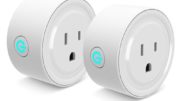Imagine how easy life would be if you came home from a busy day at work, unlocked the front door without a key and walked into a clean, comfortable house thanks to a robotic vacuum and thermostat that knows the precise indoor climate you like.
Smart technology is advancing and implementing these innovations is as straightforward as ever. All you need are a few items to build the smart home of your dreams from scratch.
Why You Might Want to Consider a Smart Home
You’re not alone if you’ve thought of integrating smart technology. Data suggests 130 million households have a minimum of one smart speaker — such as Amazon Echo or Google Nest — with projections estimating 335 million households in the next five years.
From renters to homebuyers, intelligent home automation has enabled greater control over energy consumption with lower utility expenses. It also makes everyday tasks easier and improves at-home comfortability.
For homeowners looking to rent out or sell an older or inherited home, prospective buyers may pay more for smart home upgrades. According to the National Association of Realtors, 49% of buyers rank smart homes as their top design trend.
5 Essentials for Building a Smart Home From Scratch
Building a smart home from scratch is easier than you think. Simply install these five home automation essentials to optimize for enhanced functionality and energy efficiency.
1. Voice Control
The global voice recognition market is forecasted to reach $27.16 billion by 2026, a 16.8% increase from 2021.
Voice assistants have become increasingly popular for controlling different devices, such as lights or the television. You won’t have to lift a finger to operate appliances as long as they support voice control.
Voice assistants are widely available through Amazon, Google and Apple and are easy to install. Just say a command and your voice control technology will do the hard work for you.
2. Mobile Control
Similar to voice assistants, integrating mobile control allows you to perform the following functions from your smartphone:
- Remotely control your home’s temperature by linking your smart thermostat.
- Monitor your home security in real-time.
- Feed your pet remotely using a remote food dispenser.
- Control your home’s lighting, including dimmers and color-changing features.
- Turn on your coffee maker.
- Start your car from inside the house — ideal for a cold morning.
Many homeowners also include smart door locks in their mobile control upgrades. Can you truly build a tech-savvy home without some form of smart entry? More than 12 million houses have a smart door lock, citing the most prominent benefits as reducing key-replacement costs and keeping an eye on who can enter the house.
Of course, you might also use your smartphone to control your at-home security system. Many companies now customize packages for customers to turn their alarms on and off from a mobile app.
3. Smart Thermostat
Improve your home’s temperature comfortability and save money on your heating and cooling bill by installing a smart thermostat. For most homeowners building a smart home, this innovation is one of the first they consider.
Smart thermostats are compatible with HVAC systems installed after 1975 and may need a more reliable power connection to your Wi-Fi network. Ultimately, the brand you select will have different requirements.
Homeowners with these advanced thermostats benefit from machine learning capabilities that remember your preferences and create an operative schedule. Geofencing features also inform the smart thermostat when you’re coming home to adjust your temperature accordingly.
4. Smart Plugs
Smart plugs plug into outlets, allowing you to command home appliances through your voice assistant or mobile device.
For instance, saying, “Alexa, turn on the coffee maker,” will get you a fresh cup of hot coffee in a few minutes. Likewise, you can also turn on a lamp or run a fan in a hot room by going into the app.
Other ways you might utilize smart plugs in your home include:
- Scheduling the Christmas lights to turn on at a particular time.
- Setting timers to turn your indoor or outdoor lights on when you travel.
- Turning off the living room lamp after you’re in your bedroom to avoid stumbling in the dark.
- Shutting down the slow cooker if you’re running late from work.
Additionally, smart plugs help you track energy vampires, which waste 5% to 10% of energy and cost homeowners about $100 annually.
5. Intelligent Lighting
Like other wireless technologies, smart lighting connects to your mobile device and lets you control it with an app. However, unless you’re home, you’ll need a bridge — a cloud-based channel between your lights and phone — for remote light management.
Use intelligent lighting to change brightness, create light schedules, set the mood with dimmers, connect to motion sensors or even change colors.
Smart lighting uses light-emitting diodes (LEDs), which are 75% more energy efficient than incandescent light bulbs and last 25 times longer. They also emit 90% less heat than incandescent bulbs, which means less time running your air conditioner and more savings in your pocket.
A Smart Home Is a Functional Home
Life has never been easier with smart home essentials. When building a smart home from scratch, consider which technologies and features you’ll benefit from the most. Of course, aim for functionality and savings above all else.
This article is sponsored by Solid Signal. Shop at Solid Signal for everything you need for your smart home.





